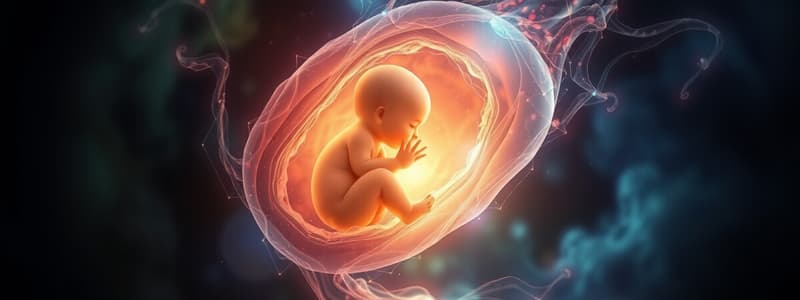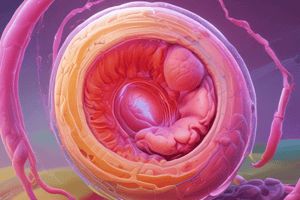Podcast
Questions and Answers
What is the primary role of the amniotic sac during fetal development?
What is the primary role of the amniotic sac during fetal development?
- To assist in the formation of blood cells
- To support the implantation process
- To provide early nutritional support to the embryo
- To cushion and protect the developing embryo and fetus (correct)
What layer contributes to the formation of the chorion?
What layer contributes to the formation of the chorion?
- Cytotrophoblast layer (correct)
- Extraembryonic mesoderm
- Hypoblast layer
- Amnioblast layer
What is the primary function of the umbilical vesicle during early development?
What is the primary function of the umbilical vesicle during early development?
- To develop the outer protective layer
- To provide early nutritional support to the embryo (correct)
- To produce amniotic fluid
- To create the amniotic cavity
Which cells line the primary umbilical vesicle?
Which cells line the primary umbilical vesicle?
What structure forms the cushioning environment for the fetus?
What structure forms the cushioning environment for the fetus?
From which cavity does the umbilical vesicle originate?
From which cavity does the umbilical vesicle originate?
Which layer forms the amnion?
Which layer forms the amnion?
What does the exocoelomic membrane eventually become?
What does the exocoelomic membrane eventually become?
What are the two layers that the embryoblast differentiates into during the formation of the bilaminar embryonic disc?
What are the two layers that the embryoblast differentiates into during the formation of the bilaminar embryonic disc?
Which structure is specifically formed from the hypoblast layer of the bilaminar embryonic disc?
Which structure is specifically formed from the hypoblast layer of the bilaminar embryonic disc?
What is the primary function of the epiblast during embryonic development?
What is the primary function of the epiblast during embryonic development?
In which week of embryological development does implantation occur?
In which week of embryological development does implantation occur?
Which of the following best describes the role of the chorion during embryological development?
Which of the following best describes the role of the chorion during embryological development?
What is the primary function of the chorion during development?
What is the primary function of the chorion during development?
The lacunae formed in syncytiotrophoblasts are primarily responsible for which of the following?
The lacunae formed in syncytiotrophoblasts are primarily responsible for which of the following?
Which extraembryonic mesoderm specifically surrounds the umbilical vesicle?
Which extraembryonic mesoderm specifically surrounds the umbilical vesicle?
What structure becomes the umbilical cord during development?
What structure becomes the umbilical cord during development?
What forms the maternal portion of the placenta?
What forms the maternal portion of the placenta?
Which component is crucial for the development of primary chorionic villi?
Which component is crucial for the development of primary chorionic villi?
What is the role of the extraembryonic coelom?
What is the role of the extraembryonic coelom?
Which layer of the chorion consists of extraembryonic somatic mesoderm and two layers of trophoblasts?
Which layer of the chorion consists of extraembryonic somatic mesoderm and two layers of trophoblasts?
How does the developing fetus and amniotic cavity relate to the chorionic cavity over time?
How does the developing fetus and amniotic cavity relate to the chorionic cavity over time?
What becomes of the small openings known as extraembryonic coelomic spaces?
What becomes of the small openings known as extraembryonic coelomic spaces?
What characterizes primary spermatocytes in terms of ploidy and function?
What characterizes primary spermatocytes in terms of ploidy and function?
What is the outcome of the second meiotic division of secondary spermatocytes?
What is the outcome of the second meiotic division of secondary spermatocytes?
During spermiogenesis, what happens to the cytoplasm of spermatids?
During spermiogenesis, what happens to the cytoplasm of spermatids?
What role do fimbriae play in the female reproductive system?
What role do fimbriae play in the female reproductive system?
At which stage does the oocyte leave the ovary?
At which stage does the oocyte leave the ovary?
Which characteristic is true of spermatozoa after maturation?
Which characteristic is true of spermatozoa after maturation?
Which process is primarily responsible for the change in shape during embryonic development?
Which process is primarily responsible for the change in shape during embryonic development?
What is the main role of spermatogonia in the male reproductive process?
What is the main role of spermatogonia in the male reproductive process?
Which process leads to the formation of the tail of the sperm?
Which process leads to the formation of the tail of the sperm?
What is the function of the ampullae in the uterine tubes?
What is the function of the ampullae in the uterine tubes?
What distinguishes secondary spermatocytes from primary spermatocytes?
What distinguishes secondary spermatocytes from primary spermatocytes?
What describes the induction process in embryogenesis?
What describes the induction process in embryogenesis?
What structural feature is primarily associated with the acrosome of the sperm?
What structural feature is primarily associated with the acrosome of the sperm?
During which stage does the fertilized egg become a morula?
During which stage does the fertilized egg become a morula?
What key event occurs when primary spermatocytes undergo meiotic division?
What key event occurs when primary spermatocytes undergo meiotic division?
What describes the role of pluripotent cells in differentiation?
What describes the role of pluripotent cells in differentiation?
What drives embryological development in relation to genetic plans?
What drives embryological development in relation to genetic plans?
What does the term 'cleavage' refer to in the context of embryological development?
What does the term 'cleavage' refer to in the context of embryological development?
Which hormone is primarily produced by the ovary during ovulation?
Which hormone is primarily produced by the ovary during ovulation?
What is the main function of the uterine tube in reproduction?
What is the main function of the uterine tube in reproduction?
Flashcards are hidden until you start studying
Study Notes
Amnion and Amniotic Sac
- Amniotic cavity forms as epiblast cells separate; amnion is a thin membrane from amnioblasts.
- The amnion creates the amniotic sac, which encompasses and protects the developing fetus.
- Functions of the amnion include cushioning the embryo/fetus with amniotic fluid and maintaining a stable environment.
Umbilical Vesicle (Yolk Sac)
- Originates from the blastocyst cavity, forming the primary umbilical vesicle lined by hypoblast cells.
- Surrounded by extraembryonic mesoderm, which supports and nourishes the embryo.
- Provides early nutritional support before placenta formation and aids in blood cell formation and germ cell development.
Chorion
- Formed from trophoblast layers of the blastocyst (cytotrophoblast and syncytiotrophoblast) with extraembryonic mesoderm.
- Small openings fuse to form the extraembryonic coelom, surrounding the amniotic cavity and bilaminar disc.
- Critical for placenta formation, facilitating nutrient, gas, and waste exchange via lacunae filled with maternal blood.
Structure Definitions
- Chorion: Encompasses amniotic sac and embryo; essential for placenta development.
- Chorionic Sac: Contains trophoblasts and lacunar network.
- Chorionic Cavity: Surrounds amniotic sac, embryo, and umbilical vesicle, formed from extraembryonic coelom.
- Connecting Stalk: Links chorion to amniotic cavity and becomes the umbilical cord.
- Primary Chorionic Villi: Outgrowths from cytotrophoblast that develop into the placenta.
Spermatogenesis Overview
- Primary Spermatocytes: Result from Type A spermatogonia; diploid (2n) and undergo meiosis I.
- Secondary Spermatocytes: Haploid (n) cells from primary spermatocytes after meiosis I, undergo meiosis II.
- Spermatids: Haploid cells from secondary spermatocytes after meiosis II; undergo spermiogenesis.
- Spermatozoa: Mature sperm capable of fertilizing an ovum; gain motility and enter the male reproductive tract.
Processes Driving Embryological Development
- Genetic interaction with the environment guides embryological development.
- Growth involves mitosis and extracellular matrix production.
- Morphogenesis refers to shape changes during development.
- Differentiation is driven by pluripotent cell density influenced by lineage and environmental cues.
- Induction involves intracellular messaging that regulates genetic activity during tissue development.
Week 1 of Embryological Development
- Ovary: Releases oocyte during ovulation; secretes hormones like estrogen and progesterone.
- Fimbriae: Finger-like projections that guide oocyte into the uterine tube.
- Infundibulum: Funnel-shaped part of the uterine tube that transports oocyte.
- Uterine/Fallopian Tube: Conduit for oocyte travel; site of sperm capacitation.
- Ampullae: Wider uterine tube portion where fertilization occurs.
- Blastocyst Formation: Introduction of embryoblast (epiblast and hypoblast) and trophoblast (syncytiotrophoblast and cytotrophoblast) during implantation.
Week 2 of Embryological Development
- Bilaminar Embryonic Disc: Formed from inner cell mass, differentiates into epiblast and hypoblast.
- Amnion: Derived from the epiblast; forms the amniotic sac for fetal protection.
- Umbilical Vesicle: Also known as the yolk sac; nutritional source until placenta forms.
- Chorion: Contributes to placenta formation and facilitates nutrient/gas exchange.
Bilaminar Embryonic Disc Development
- Formed from inner cell mass of blastocyst, splits into epiblast (gives rise to germ layers) and hypoblast (contributes to yolk sac).
- Epiblast cells undergo gastrulation to form three germ layers, paving the way for organ development.
Studying That Suits You
Use AI to generate personalized quizzes and flashcards to suit your learning preferences.




